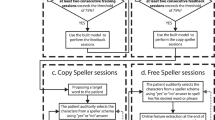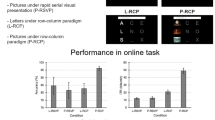Abstract
Many studies reported that ERP-based BCIs can provide communication for some people with amyotrophic lateral sclerosis (ALS). ERP-based BCIs often present characters within a matrix that occupies the center of the visual field. However, several studies have identified some concerns with the matrix-based approach. This approach may lead to fatigue and errors resulting from flashing adjacent stimuli, and is impractical for users who might want to use the BCI in tandem with other software or feedback in the center of the monitor. In this paper, we introduce and validate an alternate ERP-based BCI display approach. By presenting stimuli near the periphery of the display, we reduce the adjacency problem and leave the center of the display available for feedback or other applications. Two ERP-based display approaches were tested on 18 ALS patients to: (1) compare performance between a conventional matrix speller paradigm (Matrix-P, mean visual angle 6°) and a new speller paradigm with peripherally distributed stimuli (Peripheral-P, mean visual angle 8.8°); and (2) assess performance while spelling 42 characters online continuously, without a break. In the Peripheral-P condition, 12 subjects attained higher than 80% feedback accuracy during online performance, and 7 of these subjects obtained higher than 90% accuracy. The experimental results showed that the Peripheral-P condition yielded performance comparable to the conventional Matrix-P condition (p > 0.05) in accuracy and information transfer rate. This paper introduces a new display approach that leaves the center of the monitor open for feedback and/or other display elements, such as movies, games, art, or displays from other AAC software or conventional software tools.







Similar content being viewed by others
References
Acqualagna L, Blankertz B (2013) Gaze-independent BCI-spelling using rapid serial visual presentation (RSVP). Clin Neurophysiol 124:901–908
Allison BZ, McFarland DJ, Schalk G, Zheng SD, Jackson MM, Wolpaw JR (2008) Towards an independent brain-computer interface using steady state visual evoked potentials. Clin Neurophysiol 119:399–408
Allison BZ, Leeb R, Brunner C, Muller-Putz GR, Bauernfeind G, Kelly JW, Neuper C (2012) Toward smarter BCIs: extending BCIs through hybridization and intelligent control. J Neural Eng 9:013001
Bai LJ, Yu TY, Li YQ (2015) A brain computer interface-based explorer. J Neurosci Methods 244:2–7
Birbaumer N et al (1999) A spelling device for the paralysed. Nature 398:297–298
Brunner P, Joshi S, Briskin S, Wolpaw JR, Bischof H, Schalk G (2010) Does the ‘P300’ speller depend on eye gaze? J Neural Eng 7:056013
Cipresso P et al (2012) The use of P300-based BCIs in amyotrophic lateral sclerosis: from augmentative and alternative communication to cognitive assessment. Brain Behav 2:479–498
Donaghy C, Thurtell MJ, Pioro EP, Gibson JM, Leigh RJ (2011) Eye movements in amyotrophic lateral sclerosis and its mimics: a review with illustrative cases. J Neurol Neurosurg Psychiatry 82:110–116
Farwell LA, Donchin E (1988) Talking off the top of your head: toward a mental prosthesis utilizing event-related brain potentials. Electroencephalogr Clin Neurophysiol 70:510–523
Feng JK et al (2018) Towards correlation-based time window selection method for motor imagery BCIs. Neural Netw 102:87–95
Hoffmann U, Vesin JM, Ebrahimi T, Diserens K (2008) An efficient P300-based brain-computer interface for disabled subjects. J Neurosci Methods 167:115–125
Holz EM, Botrel L, Kübler A (2015) Independent home use of Brain Painting improves quality of life of two artists in the locked-in state diagnosed with amyotrophic lateral sclerosis. Brain Comput Interfaces 2:117–134
Hsu HT et al (2016) Evaluate the feasibility of using frontal SSVEP to implement an SSVEP-based BCI in young, elderly and ALS groups. IEEE Trans Neural Syst Rehabil Eng 24:603–615
Huang MQ, Daly I, Jin J, Zhang Y, Wang XY, Cichocki A (2016) An exploration of spatial auditory BCI paradigms with different sounds: music notes versus beeps. Cogn Neurodyn 10:201–209
Huang MQ, Jin J, Zhang Y, Hu DW, Wang XY (2018) Usage of drip drops as stimuli in an auditory P300 BCI paradigm. Cogn Neurodyn 12:85–94
Jin J et al (2010) P300 Chinese input system based on Bayesian LDA. Biomed Tech 55:5–18
Jin J, Allison BZ, Sellers EW, Brunner C, Horki P, Wang XY, Neuper C (2011) An adaptive P300-based control system. J Neural Eng 8:036006
Jin J, Allison BZ, Zhang Y, Wang XY, Cichocki A (2014a) An ERP-based BCI using an oddball paradigm with different faces and reduced errors in critical functions. Int J Neural Syst 24:1450027
Jin J, Daly I, Zhang Y, Wang XY, Cichocki A (2014b) An optimized ERP brain-computer interface based on facial expression changes. J Neural Eng 11:036004
Jin J, Sellers EW, Zhou S, Zhang Y, Wang X, Cichocki A (2015) A P300 brain-computer interface based on a modification of the mismatch negativity paradigm. Int J Neural Syst 25:1550011
Jin J, Zhang HH, Daly I, Wang XY, Cichocki A (2017) An improved P300 pattern in BCI to catch user’s attention. J Neural Eng 14:036001
Kaufmann T, Holz EM, Kubler A (2013a) Comparison of tactile, auditory, and visual modality for brain-computer interface use: a case study with a patient in the locked-in state. Front Neurosci 7:129
Kaufmann T, Schulz SM, Koblitz A, Renner G, Wessig C, Kubler A (2013b) Face stimuli effectively prevent brain-computer interface inefficiency in patients with neurodegenerative disease. Clin Neurophysiol 124:893–900
Kaufmann T, Herweg A, Kubler A (2014) Toward brain-computer interface based wheelchair control utilizing tactually-evoked event-related potentials. J Neuroeng Rehabil 11:7
Keller J et al (2015) Eye-tracking controlled cognitive function tests in patients with amyotrophic lateral sclerosis: a controlled proof-of-principle study. J Neurol 262:1918–1926
Kubler A, Kotchoubey B, Kaiser J, Wolpaw JR, Birbaumer N (2001) Brain-computer communication: unlocking the locked in. Psychol Bull 127:358–375
Kubler A et al (2005) Patients with ALS can use sensorimotor rhythms to operate a brain-computer interface. Neurology 64:1775–1777
Kuebler A, Kotchoubey B, Salzmann HP, Ghanayim N, Perelmouter J, Homberg V, Birbaumer N (1998) Self-regulation of slow cortical potentials in completely paralyzed human patients. Neurosci Lett 252:171–174
Leeb R, Sagha H, Chavarriaga R, Millan Jdel R (2011) A hybrid brain-computer interface based on the fusion of electroencephalographic and electromyographic activities. J Neural Eng 8:025011
Lewis M, Rushanan S (2007) The role of physical therapy and occupational therapy in the treatment of amyotrophic lateral sclerosis. Neurorehabilitation 22:451–461
Li Y, Pan J, Long J, Yu T, Wang F, Yu Z, Wu W (2016) Multimodal BCIs: target detection, multidimensional control, and awareness evaluation in patients with disorder of consciousness. Proc IEEE 104:332–352
Mainsah BO, Collins LM, Colwell KA, Sellers EW, Ryan DB, Caves K, Throckmorton CS (2015) Increasing BCI communication rates with dynamic stopping towards more practical use: an ALS study. J Neural Eng 12:016013
Mak JN et al (2012) EEG correlates of P300-based brain-computer interface (BCI) performance in people with amyotrophic lateral sclerosis. J Neural Eng 9:026014
Marchetti M, Priftis K (2015) Brain-computer interfaces in amyotrophic lateral sclerosis: a metanalysis. Clin Neurophysiol 126:1255–1263
Martinez-Cagigal V, Gomez-Pilar J, Alvarez D, Hornero R (2017) An asynchronous P300-based brain-computer interface web browser for severely disabled people. IEEE Trans Neural Syst Rehab Eng 25:1332–1342
McCane LM et al (2014) Brain-computer interface (BCI) evaluation in people with amyotrophic lateral sclerosis. Amyotroph Lateral Scler Front Degener 15:207–215
McCane LM et al (2015) P300-based brain-computer interface (BCI) event-related potentials (ERPs): people with amyotrophic lateral sclerosis (ALS) vs. age-matched controls. Clin Neurophysiol 126:2124–2131
Millan JDR et al (2010) Combining brain-computer interfaces and assistive technologies: state-of-the-art and challenges. Front Neurosci 4:161
Piccione F et al (2006) P300-based brain computer interface: reliability and performance in healthy and paralysed participants. Clin Neurophysiol 117:531–537
Puanhvuan D, Khemmachotikun S, Wechakarn P, Wijarn B, Wongsawat Y (2017) Navigation-synchronized multimodal control wheelchair from brain to alternative assistive technologies for persons with severe disabilities. Cogn Neurodyn 11:117–134
Riccio A et al (2013) Attention and P300-based BCI performance in people with amyotrophic lateral sclerosis. Front Hum Neurosci 7:732
Roche JC et al (2012) A proposed staging system for amyotrophic lateral sclerosis. Brain 135:847–852
Ron-Angevin R, Varona-Moya S, da Silva-Sauer L (2015) Initial test of a T9-like P300-based speller by an ALS patient. J Neural Eng 12:046023
Sellers EW, Donchin E (2006) A P300-based brain-computer interface: initial tests by ALS patients. Clin Neurophysiol 117:538–548
Sellers EW, Vaughan TM, Wolpaw JR (2010) A brain-computer interface for long-term independent home use. Amyotrophic Lateral Scler 11:449–455
Severens M, Van der Waal M, Farquhar J, Desain P (2014) Comparing tactile and visual gaze-independent brain-computer interfaces in patients with amyotrophic lateral sclerosis and healthy users. Clin Neurophysiol 125:2297–2304
Wang HT, Li YQ, Long JY, Yu TY, Gu ZH (2014) An asynchronous wheelchair control by hybrid EEG-EOG brain-computer interface. Cogn Neurodyn 8:399–409
Wolpaw JR, McFarland DJ, Neat GW, Forneris CA (1991) An EEG-based brain-computer interface for cursor control. Electroencephalogr Clin Neurophysiol 78:252–259
Wolpaw JR et al (2000) Brain-computer interface technology: a review of the first international meeting. IEEE Trans Rehabil Eng 8:164–173
Xu MP et al (2016) Use of a steady-state baseline to address evoked vs. oscillation models of visual evoked potential origin. NeuroImage 134:204–212
Xu MP, Xiao XL, Wang YJ, Qi HZ, Jung TP, Ming D (2018) A brain-computer interface based on miniature-event-related potentials induced by very small lateral visual stimuli. IEEE Trans Biomed Eng 65:1166–1175
Yadav AP, Nicolelis MAL (2017) Electrical stimulation of the dorsal columns of the spinal cord for Parkinson’s disease. Mov Disord 32:820–832
Yin EW, Zhou ZT, Jiang J, Yu Y, Hu DW (2015) A dynamically optimized SSVEP brain-computer interface (BCI) speller. IEEE Trans Biomed Eng 62:1447–1456
Zhang Y, Zhou GX, Jin J, Wang XY, Cichocki A (2014) Frequency recognition in SSVEP-based BCI using multiset canonical correlation analysis. Int J Neural Syst 24:1450013
Zhang Y, Zhou GX, Jin J, Wang XY, Cichocki A (2015) Optimizing spatial patterns with sparse filter bands for motor-imagery based brain-computer interface. J Neurosci Methods 255:85–91
Zhang YS, Guo DQ, Xu P, Zhang Y, Yao DZ (2016) Robust frequency recognition for SSVEP-based BCI with temporally local multivariate synchronization index. Cogn Neurodyn 10:505–511
Acknowledgements
This work was supported by the National key research and development program 2017YFB13003002. This work was also supported in part by the Grant National Natural Science Foundation of China, under Grant Nos. 61573142, 61773164 and 91420302, and the programme of Introducing Talents of Discipline to Universities (the 111 Project) under Grant B17017.
Author information
Authors and Affiliations
Corresponding authors
Additional information
Publisher's Note
Springer Nature remains neutral with regard to jurisdictional claims in published maps and institutional affiliations.
Rights and permissions
About this article
Cite this article
Miao, Y., Yin, E., Allison, B.Z. et al. An ERP-based BCI with peripheral stimuli: validation with ALS patients. Cogn Neurodyn 14, 21–33 (2020). https://doi.org/10.1007/s11571-019-09541-0
Received:
Revised:
Accepted:
Published:
Issue Date:
DOI: https://doi.org/10.1007/s11571-019-09541-0




